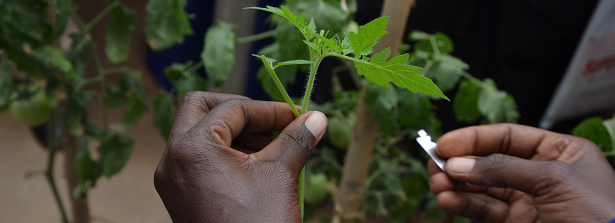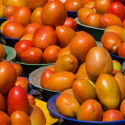Grafting: A way to boost tomato harvests from low-quality trees

The grafting technology is largely being promoted under the Applied Research Fund project “Improved Resilience through Sustainable Production of Grafted Tomatoes in Uganda (IRESO)”. Grafting transforms low quality fruit trees into the high yielding commercial varieties.
Many tropical fruit trees, including tomatoes, mango, avocado and orange, perform better when farmers merge good fruiting characteristics with resistance to disease. To accomplish this, a single stem is placed on to a root stock tree. The stem eventually merges with the root stock to form the main trunk of the tree and from then on that tree bears fruit similar to the plant the graft was taken from.
Bigger harvests
Grafting transforms low quality fruit trees into the high yielding commercial varieties. As such, these trees would be a better source of income as fruit producers each year than their value as wood products. It will ensure that the nature of the plant will be maintained and can perpetuate the specific variety of the plant yet if a farmer plants seeds, the resulting plant will not be identical.
The grafting technology, say scientists at National Crops Resources Research Institute (NaCCRI), has been embraced by farmers majoring in tomato growing because they are able to get bigger harvests leading to better earnings. This technology is largely being promoted under the Improved Resilience through Sustainable Production of Grafted Tomatoes in Uganda (IRESO) project.
Exploring options
Mr Africano Kangire, a principal research technician at NaCRRI, leads a team breeding grafted tomatoes such as the local purple tomatoes, cherry tomatoes in Uganda, which is sold out to farmers mostly in the Lake Victoria Crescent area.
For the case of tomatoes, the team is grafting varieties from Kenya and Thailand with the indigenous variety, commonly known as Kagogwa. With cherry tomatoes, it is better to graft the Asilla type of tomato.
This is because their stems are strong and can therefore hold onto the mother stem. They are also exploring options of grafting specific varieties of tomatoes on Nakkati vegetable for improved yields
Doing well
During the grafting exercise, Mr Kangire and his team, cut the mother root with a sectuer, match it with the hybrid fruit cuttings and tie them using white polythene to avoid entry of water. Covering the grafted scion enables the plant to absorb water through translocation and also allows photosynthesis to take place.
Farmers are advised to slice off the buds with pruning tools, leaving only about half of an inch of stem from each, cut the bottom portion of the branch at an angle, exposing the inner bark on one side of the angle cut.







I reside in Western part of Kenya and I would be happy to introduce to Farmers gafted tomatoes and the technology behind, regards Gerald